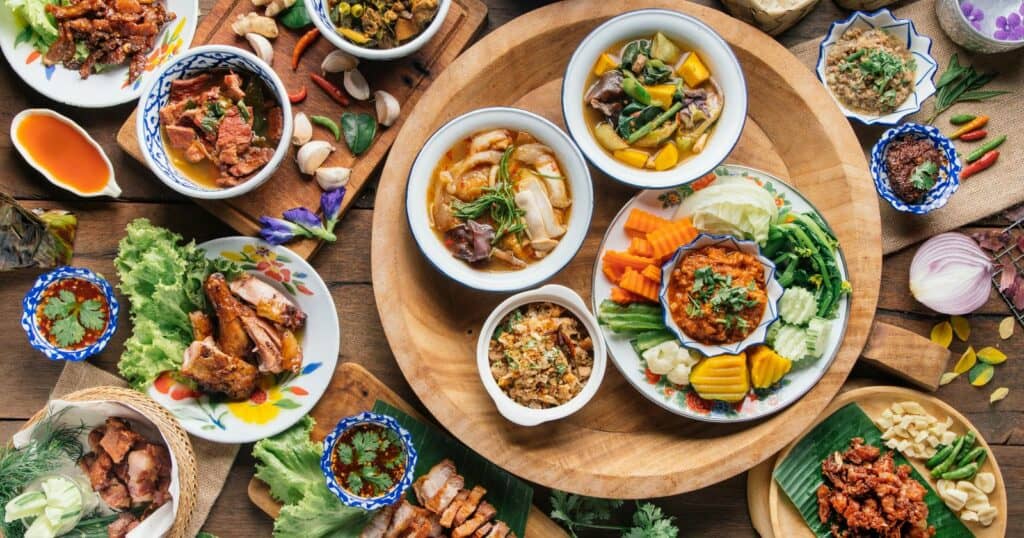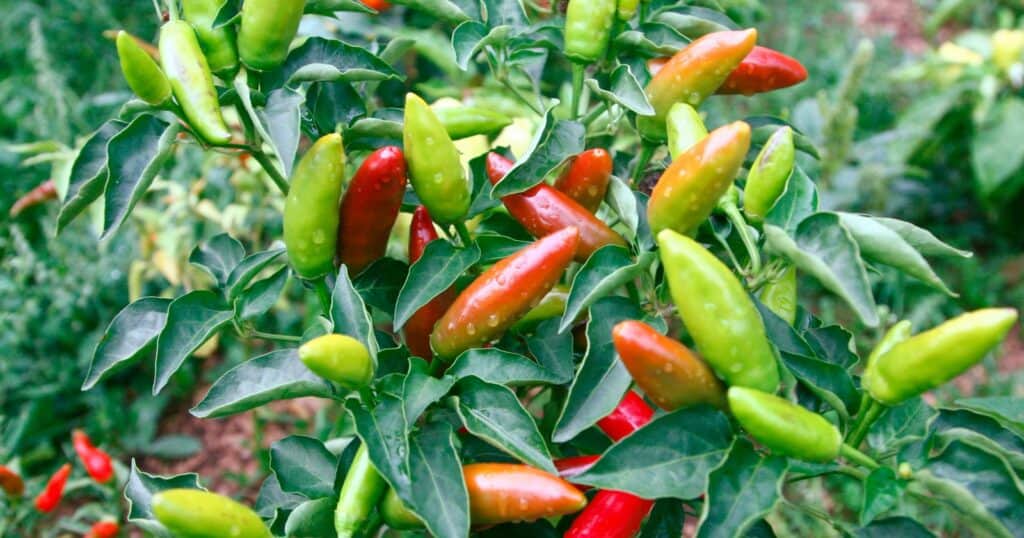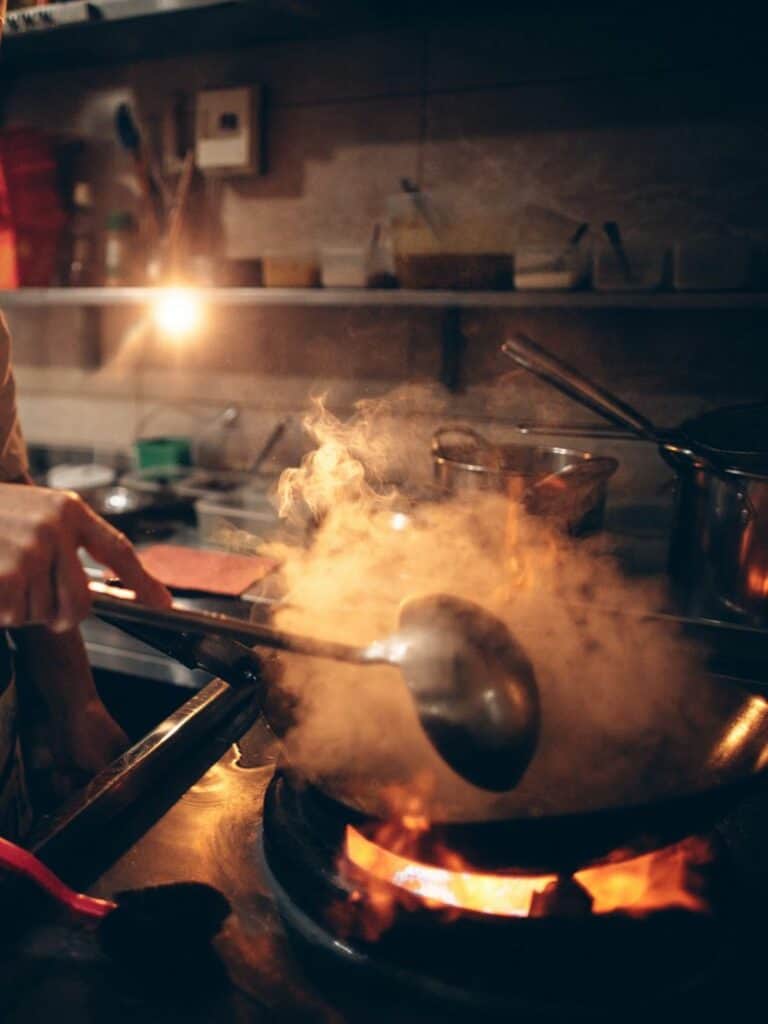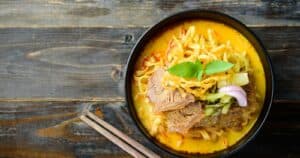You’re craving some authentic pad Thai or perhaps a steaming bowl of Tom Yum soup. But you’ve heard complaints that Thai food has a funny, off-putting smell. So you find yourself wondering: why does Thai food smell bad?
Before you write off Thai cuisine completely, let’s take a moment to unravel this mystery. The truth is, Thai food boasts some of the most wonderfully complex aromas in the culinary world.
However, some particular ingredients and cultural factors lead certain noses to perceive unpleasant odors where others experience enticing scents.
In this article, we’ll sniff out the reasons behind the pungent smells in Thai cooking, including:
- The use of aromatic herbs like galangal, kaffir lime leaves and lemongrass
- The incorporation of fermented components like fish sauce and shrimp paste
- Regional varieties of Thai food, each with their own scent profile
- Subjective differences in scent perception based on culture
Once equipped with this insider’s knowledge, you can start to appreciate the incredible bouquets that emanate from authentic Thai dishes. So plug that nose no more – it’s time to clear the air on those funky food smells!
The Distinct Aromas of Authentic Thai Cuisine
What gives Thai food its signature scent? Here are some core aromatic ingredients:
Thai Herbs
- Lemongrass – Citrusy, refreshing fragrance
- Galangal – Ginger-like with hints of pine
- Kaffir Lime Leaves – Zesty and floral lime essence
- Thai Basil – Anise-tinged, slightly sweet and spicy
Thai Spices
- Turmeric – Earthy with subtle ginger notes
- Coriander – Lemony, slightly musky aroma
- Cumin – Warm, nutty and bitter scent
Other Impactful Ingredients
- Garlic – Pungent and savory fragrance when cooked
- Chilies – Range from fruity to sharply spicy smell
- Shrimp Paste – Intense fermented seafood smell
So those are some aromas you can expect with authentic Thai cooking. Let’s see how regional cuisines differ.
Regional Aromas – A Thai Culinary Journey

Thailand’s diverse regions each have distinct culinary styles. Here’s an aromatic tour:
Northern Thai Cuisine
Focused on fresh herbs like:
- Lemongrass – lends a bright, citrusy component
- Galangal – brings an earthy bite with ginger nuances
- Kaffir Lime – provides floral and zesty lime notes
As experienced in iconic dishes like Khao Soi curry noodles.
Northeastern Thai Cuisine
Spotlights pungent herbs such as:
- Mint – cool and refreshing scent
- Cilantro – offers a fresh, grassy aroma
- Dill – features a light anise-like fragrance
Best experienced in spicy salads like Som Tam papaya.
Central Thai Cuisine
Led by aromatics like:
- Garlic – brings a sharper allium scent
- Coriander – provides a subtle lemon-sage aroma
- Pepper – lends a spicy, nose-tickling smell
As highlighted in staples like pad Thai.
Southern Thai Cuisine
Anchored by warm spices including:
- Turmeric – earthy with ginger undertones
- Cumin – smoky and nutty fragrance
- Cardamom – sweetly pungent with eucalyptus hints
Which infuse hot curries like gaeng som.
As you can see, Thai regional cuisine offers a dynamic range of scents. Now let’s look at the smell factor with fermented foods.
The Role of Fermented Ingredients
Fermented foods add complex depth to Thai cuisine. But what about the smell?
Fish Sauce
- Made from salted, fermented fish (often anchovies)
- Pungent smell amplified by prolonged fermentation
- Becomes pleasantly savory, salty and umami when cooked
Shrimp Paste
- Made from fermented ground shrimp and salt
- Intense raw smell like seafood held in sun
- Fermented funk dissipates when cooked, adding deep umami
Soybean Paste
- Made from fermented soybeans and rice
- Strong cheesy, yeasty aroma when raw
- Develops rich, savory flavor when cooked into dishes
For some, these fermented ingredients take adjusting to. But cooking tames their smell while boosting Thai food flavors.
The Impact of Chili Peppers

Chili peppers play a vital role in Thai cuisine, adding addictive heat that balances out sweet, sour, and salty flavors. However, the capsaicinoids that give chilies their kick can also create a potent smell for the uninitiated.
Thai cooking uses a diverse range of chili peppers, from the petite bird’s eye chili to the large, barrel-shaped prik kee noo. They can be eaten raw, cooked into dishes, or ground into
When cooking with chilies, the high heat causes the peppers’ oils to aerosolize into the air. As you inhale these vaporized compounds, they can irritate sensitive mucous membranes in the nose and throat.
This physical irritation is what creates that intense, eye-watering smell many associate with spicy Thai food. The sensation can be overwhelming if you’re not used to it.
However, the chili pepper smell is ephemeral. As you begin eating the Thai dish, the aromas that initially assaulted your nose give way to complex flavors.
The key is gradually acclimating your senses to the chili. Start with milder varieties before working up to the punch of a ripe habanero or tiny prik kee noo.
In time, your nose and palate will learn to appreciate the unique scent of chili peppers. You’ll realize they add just the right amount of addictive heat to balance Thailand’s sweet, sour and salty flavors.
Cooking Methods Matter

How Thai dishes are prepared greatly impacts their resulting aroma. Some cooking techniques create more robust scents than others.
Methods like stir-frying, deep-frying, and high-heat grilling allow foods to take on a seared, charred aroma. Oil from ingredients like peanuts splatter, releasing their scent.
Meanwhile, lower temperature techniques like simmering curries gently coax out delicate herbal notes. Steaming fish parcels retains light, natural smells.
Frying with peanuts oils adds a nuttiness some find off-putting. But switching to vegetable or coconut oil provides a more neutral smell.
Acrid smells can develop if meats are overcooked or if spices burn from excess heat. Proper cooking techniques ensure ingredients brown and caramelize without going bitter.
So while Thai cuisine has some inherently pungent components, cooking methodology plays a big role. Quick-cooked stir-fries will smell more robust than a gently simmered coconut curry.
Approaching Thai food with an understanding of how preparations influence aroma removes some of the mystery around its smell. You gain insight into how cooking intricately shapes overall scent.
The Noise Factor
The soundscape around us as we eat can unintentionally amplify or mute our perception of food aromas. This “noise factor” may explain why some associate Thai cuisine with bad smells.
Dining at a loud, chaotic outdoor food market could heighten awareness of Thai food’s pungent components. The sizzling grills, vendors’ yelling, and motorcycle rumbling overwhelms the senses.
This links the dishes you’re experiencing with the noisy setting. In the future, those remembered smells trigger recollections of a frenzied environment.
By contrast, eating Thai curry in a quiet restaurant with soft background music focuses you inward on the flavors. You have a calm, pleasant association with the meal.
Traveling also conditions us to recall destinations when scenting certain foods. Thai cuisine may transport your mind to the country’s loud, bustling streets.
But if first trying Thai dishes at home, that connection doesn’t develop. You judge the food by aroma and taste alone, without predetermined sensory baggage.
So don’t let past noisy conditions cloud your judgment of Thai cuisine’s scents. Approach each new dish with fresh olfactory awareness.
Debunking the Myth: Thai Food Smells Like Poop?
Some falsely claim Thai dishes smell like poop. But this myth doesn’t hold up to scrutiny. Here’s why:
Thai Food’s Diverse Aromas
With herbs, spices, vegetables, proteins and sauces, Thai food has complex, enticing aromas – not fecal odors.
Poop Smell Comes From Sulphur
The human poop smell comes from chemicals like hydrogen sulfide and methyl mercaptan. Thai food lacks these smelly compounds.
Cultural Differences in Scent Perception
Unfamiliarity with Thai cuisine’s fermented components may lead some to misinterpret the smell as bad. It’s subjective.
Proper Thai Cooking Tames Strong Scents
Any pungent smells mellow out or blend harmoniously when Thai dishes are cooked properly.
So while Thai food has distinctive aromas, there’s no basis for the erroneous claim it smells like poop. With cultural awareness and an open mind, anyone can discover the delectable scents of authentic Thai cuisine.





